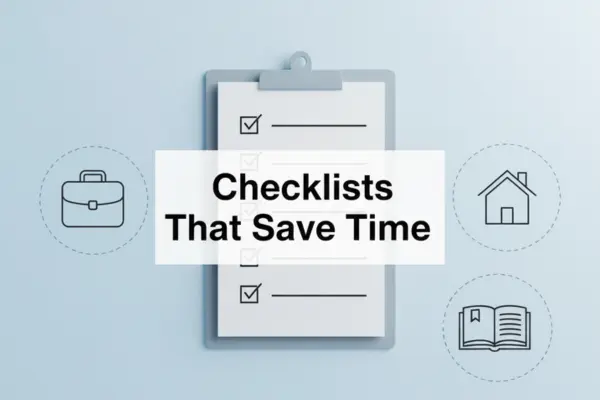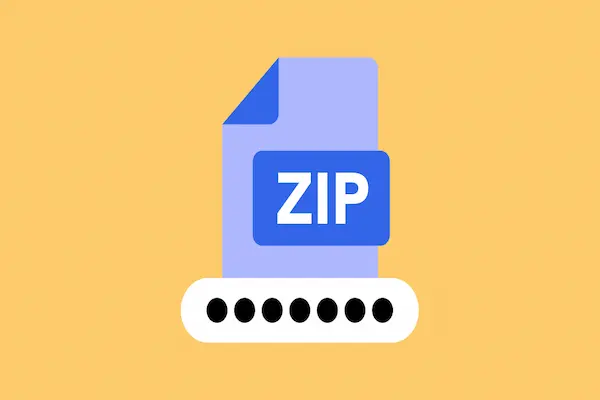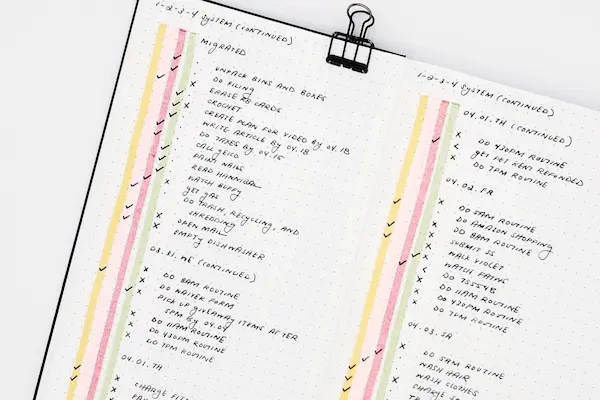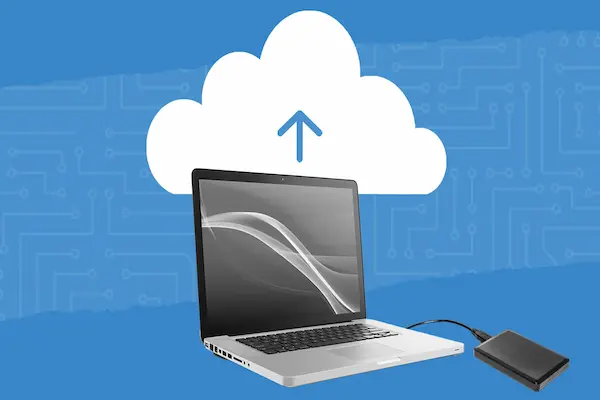Learn how to use checklists to save time, stay organized, and reduce stress with practical tips and ready-to-use templates.
Planning daily tasks may look simple, but in reality, everything mixes up in the rush.
It’s common to forget appointments, delay deliveries, or even repeat activities unnecessarily.
And this is exactly where checklists come in as powerful allies.
They turn your routine into something lighter, more practical, and much more reliable.
With a clear list in front of you, you don’t need to rely only on memory.
This way, you free up mental space to focus on what really matters.
In this article, you’ll learn how to use checklists at work, at home, and even for leisure.
You’ll discover why this simple tool works so well, which mistakes to avoid, and how to create checklists that truly save time.
And at the end, you’ll find ready-made templates so you can start using them right away.

Understanding how to use checklists
Before creating lists, it’s important to understand what they really mean.
A checklist is not just a notebook.
It’s an organizational tool that ensures nothing is forgotten.
With it, you have a clear view of what needs to be done, in the right order, and with the guarantee that each step will be completed.
Checklists are used in critical areas like medicine, aviation, and engineering precisely because they reduce human error.
And if they work in those fields, imagine how much easier they can make your personal and professional routine.
- Definition: a list of tasks or steps organized in a clear way.
- Purpose: to ensure nothing is forgotten during execution.
- Application: can be used in simple activities or complex processes.
- Benefit: reduces mistakes, saves time, and increases confidence.
Benefits of how to use checklists
When you understand how to use checklists, the benefits appear immediately.
They help you control time better, reduce anxiety, and even improve the quality of results.
On top of that, they give you the satisfying feeling of progress each time you check off an item.
- More organization: everything you need is in one place.
- Less stress: you don’t need to rely solely on memory.
- Higher productivity: prevents rework and forgotten tasks.
- Clear priorities: makes it easier to see what’s urgent and what can wait.
- Constant motivation: each check feels like a small victory.
Common challenges and how to avoid them
Even though checklists are simple, many people make mistakes when creating them.
That can turn the tool into something heavy instead of practical.
But with a few adjustments, you can avoid frustration and make the most of them.
- Overly long list → Break it down into smaller lists by theme or by day.
- Vague tasks → Use clear action verbs, like “send report” instead of just “report.”
- No review → Keep your lists updated, otherwise they’ll lose relevance.
- Mixed priorities → Separate what’s urgent from what’s optional.
- Ignoring digital options → Use apps with reminders and synchronization.
Tools and platforms for how to use checklists
There are plenty of tools that make checklists easy and accessible.
From pen and paper to modern apps that sync with your phone and computer, the choice depends on your lifestyle.
| Platform | Access | Main features | Ideal for |
|---|---|---|---|
| Google Keep | App & web | Quick lists, synchronization | People who want simplicity on mobile |
| Trello | App & web | Boards, cards, and checklists | People who like organizing projects |
| Todoist | App & web | Tasks, deadlines, reminders | People who need smart lists |
| Paper planner | Physical | Manual writing, instant view | People who prefer traditional methods |
| Notion | App & web | Full customization | People who centralize everything in one |
Whether digital or on paper, the important thing is to have a clear, accessible list.
How to use checklists: step by step
For a checklist to truly save time, it’s important to follow a few basic steps.
That way, you create lists that are useful and effective.
- Define the purpose: what task or process do you want to organize?
- List the steps: write each item clearly and objectively.
- Arrange in logical order: follow a practical sequence of execution.
- Add deadlines if necessary: helps keep discipline.
- Mark priorities: highlight what cannot be delayed.
- Review the list: make sure it’s up-to-date before using.
- Check off completed tasks: enjoy the feeling of progress.
How to use checklists at work
In the workplace, checklists are far more than a to-do list.
They act as a visual guide that helps employees and teams stay aligned, reduce mistakes, and focus on what truly matters.
When applied consistently, they can completely transform the way projects are executed and how daily routines are handled.
Because everything is clearly laid out, people waste less time deciding what comes next and spend more energy actually completing tasks.
Another advantage is that checklists serve as a communication tool.
They make responsibilities visible to everyone, which avoids misunderstandings and ensures accountability.
Managers can quickly check progress, and team members know exactly what is expected of them.
This improves collaboration and creates a culture of transparency.
Checklists also work as memory aids during fast-paced meetings or project reviews.
Instead of relying on memory or scattered notes, you have a clear record of what was discussed, what needs follow-up, and who owns each action.
That way, decisions become quicker, and execution gains speed.
Here are some practical examples of how to apply checklists in professional environments:
- Daily task checklist – helps individuals prioritize the most important three to five actions for the day and track progress.
- Meeting checklist – includes agenda, required documents, participant confirmations, and action items to cover before and after the session.
- Project delivery checklist – outlines every step needed to complete a deliverable, from drafting to approval and final submission.
- Quality assurance checklist – ensures that documents, designs, or products are carefully reviewed before being sent to clients.
When you make these checklists part of your routine, you not only gain control over time but also increase the quality of what your team delivers.
In the long run, this simple habit becomes a strategic tool that saves resources and strengthens professional relationships.
How to use checklists at home
At home, checklists simplify routine tasks.
They help share responsibilities among family members and prevent small chores from piling up.
They also create the feeling of an organized, stress-free household.
- Grocery shopping list.
- Weekly cleaning checklist.
- Checklist for bills and payments.
- Travel checklist (clothes, documents, electronics).
How to use checklists for studies
For students, checklists are powerful allies.
They make it easier to track what has been reviewed, which assignments are pending, and when exams are scheduled.
This increases discipline and reduces the feeling of being overwhelmed by content.
- Subject review checklist.
- Assignment and deadline checklist.
- Required reading checklist.
- Exam prep checklist.
How to use checklists for events and trips
Anyone who’s organized a party or trip knows how easy it is to forget details.
With a checklist, you ensure that everything is planned without stress.
Even better: you can enjoy the event or trip with peace of mind, knowing that everything was covered in advance.
- Event checklist (venue, guests, food, decoration).
- Travel checklist (tickets, hotel, suitcase, documents).
- Safety checklist (lock windows, unplug devices, notify neighbors).
How to use checklists with templates
You don’t always need to start from scratch.
You can use ready-made checklist templates and adapt them to your situation.
This saves time and serves as a guide so you don’t forget important steps.
Daily checklist template
- Wake up and make the bed.
- Review the day’s agenda.
- Gather documents or materials.
- Prepare main meals.
- Check unfinished tasks before bed.
Work checklist template
- Check priority emails.
- Define the 3 most important tasks.
- Attend scheduled meetings.
- Update project progress.
- Review daily deliveries.
Travel checklist template
- Buy tickets.
- Book accommodation.
- Gather personal documents.
- Pack clothes and essentials.
- Arrange transportation to the airport.
How to use checklists and stay motivated
Creating lists is easy, but maintaining them requires discipline and motivation.
That’s why you should turn checklist use into a pleasant habit.
Celebrate each time you check off an item.
This releases dopamine in the brain and reinforces your desire to keep going.
- Use colors to mark progress.
- Share your lists with someone you trust.
- Create small rewards for completed lists.
- Always keep lists short and objective.
Best practices for how to use checklists
For checklists to work, adopting best practices makes all the difference.
There’s no point in creating an endless list and never using it.
The secret is to keep things simple, practical, and realistic.
- Create short and specific lists.
- Use action verbs in each item.
- Update your lists regularly.
- Adapt ready-made templates to your reality.
- Leave space for quick notes.
This way, your checklists stop being just paper or pixels and become tools that truly save time.
Compliance and transparency
This article was developed for educational purposes and aims to share good practices in personal and professional organization.
We have no affiliation, endorsement, or control over the brands, tools, or platforms mentioned here. Any examples are purely illustrative.
The information provided is general and should be adapted according to each person’s own reality and needs.
Our goal is to ensure clear, safe, and reliable content, aligned with compliance and Google’s best practice guidelines.





